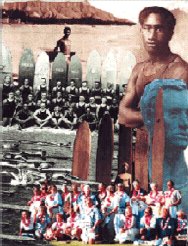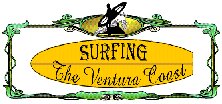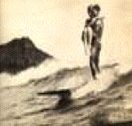
Macquari University
Studies of Asian Society & Culture in the Secondary School
Popular Culture - Surfing
John Flint
October 26, 1999

TABLE OF CONTENTS
 1. INTRODUCTION
1. INTRODUCTION
2. HISTORY OF SURF CULTURE
3. CONTROL OF SURF CULTURE
4. CONSUMPTION OF SURF CULTURE
5. SOCIETAL PERCEPTIONS OF SURF CULTURE
6. SURF CULTURES CONTRIBUTION TO SOCIAL CHANGE
7. THE FUTURE OF SURF CULTURE
8. REFERENCES
9. PICTORIAL APPENDIX
 1. Introduction
1. Introduction
The term culture refers to "the meanings that people learn from and share with each other" (MacPherson, Curtis & Loy 1989 p249), this includes descriptive and normative beliefs which are shared by members of the cultural group. Popular Culture can then be defined as the normative values and beliefs that are that are available for the general mass of people on local, national or global scale. This culture has some times been referred to as "Low Culture" ( Lovat, Parnell, Follers, Armstrong, Jones & Hill. 1994, p180) as compared to "High Culture such as opera" (Lovat et al; 1994, p180).
The Nature of Popular Culture changes over time as ideas of what is popular change within local, national or global communities. This idea of change is driven by such mechanisms as the Mass media such as television, Film, music, magazines and more recently the inter- net. In fact many of these media may be thought of as Popular Culture. These cultures generally are youthful and have shared values that are embodied by their own mythology, heroes, dress and jargon.
At times these Popular Cultures may be seen as undesirable subculture by the wider community because of certain values and attitudes such as drug use and sexual promiscuity. However these Popular Cultures can influence mainstream culture, for example environmental values and are in turn influenced by the mainstream such as professionalism and commercialisation.
Large Trans National Corporations, perpetuate Popular Cultures through the promotion of paraphernalia such as magazines, movies, accessories, equipment and clothing. Today the selling of Popular Culture to the youth market fosters multi billion dollar industries on a global basis. These industries using sophisticated technology promote their products and paraphernalia to those who identify with that culture, exploiting the value and belief systems that very culture has developed. In return that Popular Culture may grow from a small localised counter culture, such as surfing, into a respected pursuit or way of life for millions of people on a global basis.
This paper will examine the sport of surf board riding or "surfing" as a Popular Culture. The paper will discuss the history of the sport, who controls surf culture, consumption of surf culture, societal perceptions of surfing, its contribution to social change and the future of surfing.
2. HISTORY OF SURF CULTURE
 For over a
thousand years surfing has been a quasi religious experience (Krakauer,
1989) that has emphasised being close to nature and a spiritual or
soulful way of life. Surfing culture originated in Hawaii and was a
spiritual way of life for thousands (Crawford 1995) including Hawaiian
Royalty. Surfing was a way of life for these seafaring people and
formed an integral part of their society. Missionaries in the 19th
Century disapproved of the sport because the Hawaiians both male and
female were seen as lazy only wanting to pursue their surfing lifestyle
instead of work and the surfing population declined (Crawford 1995).
The sport was rekindled when figures such as the athlete and Hollywood
star Hawaiian Duke Kahanamoku (right) promoted the sport in California
and introduced the sport of surfing into Australia in 1915 (Morton;
1999).
For over a
thousand years surfing has been a quasi religious experience (Krakauer,
1989) that has emphasised being close to nature and a spiritual or
soulful way of life. Surfing culture originated in Hawaii and was a
spiritual way of life for thousands (Crawford 1995) including Hawaiian
Royalty. Surfing was a way of life for these seafaring people and
formed an integral part of their society. Missionaries in the 19th
Century disapproved of the sport because the Hawaiians both male and
female were seen as lazy only wanting to pursue their surfing lifestyle
instead of work and the surfing population declined (Crawford 1995).
The sport was rekindled when figures such as the athlete and Hollywood
star Hawaiian Duke Kahanamoku (right) promoted the sport in California
and introduced the sport of surfing into Australia in 1915 (Morton;
1999).
Today surf culture largely perpetuates the early Hawaiian attitudes and values as being a spiritual and soulful experience. In the surfers language "Soul Surfing" (Brown 1997) is a lifestyle that is focussed on surfing for pleasure and the joy of being close to nature. Soul Surfers live by the coast and spend as much time as they can in the sea sharing the experiences with their mates. These surfers are fit, agile and attract the best looking "chicks" (Brown 1997), many young men identify with that image. However, only in the 1990's has the large scale active participation of women in surfing eventuated (Marsh 1997; Cummins 1997).
During the 1950's and 60's surfing became more popular through the media's expression of the culture in the American Movies "Gidget" (Crawford 1995; Krakauer 1989) and "The Endless Summer"(Geeslin & Mathison; 1986) were young beautiful teenagers enjoyed fun, sun filled lives in beautiful locations around the world. At this time Californian surf music by the Beach Boys was sweeping the world (Crawford 1995). Many surfers travel the world looking for the perfect wave and " Are like dancers on a Liquid stage" (Bovee 1995). During this time Australian Surfing legends such as Midget Farrelly and Nat Young were born (Peninsular Surf Centre, 1998). During the 1970's and 80's drugs like Marijuana have played a part in giving surfers the reputation as being "drugged out hippies" Brown (1997). "They were mostly the rogues of the world, the guys who were looking for something different, something a bit more exciting. The sort of guy who would travel to Tierra del Fuego rather than get on a tramp steamer to London" Bruce Channon (Brown 1997)
The advent of Professional Surfing in the 1970's saw a string of new Australian surf heros that were international stars such as Michael Peterson, "The Bronzed Aussies", Mark Richards and others (Brown 1997). This changed the nature of surf culture is causing a rift between the soul surfers and the new clean cut money oriented surfers promoted by business interests to sell more clothing and equipment especially in urban areas. This has produced surfing mega stars such as American Kelly Slater who has been mobbed in Australian Shopping centres by fans (Brown 1997). "Back in the 1960's they say, the surfing ideal was a fluid and graceful attempt to match the flow of the wave. But today professional surfers use shorter and quicker boards in an aggressive, thrashing, teeth gritting display of advanced technique. . The jargon is telling: they "slash" and "rip" the wave or get "hammered" trying." (The economist 1995)
3. CONTROL OF SURF CULTURE
Surf culture is now perpetuated through the mass media to promote the products and paraphernalia that has generated a $7 Billion global industry controlled by companies such as Rip Curl, Quicksilver and Billabong across 70 countries (Brown 1997). Other multinational companies such as Coca Cola (Brown 1997), Motorola, Chevron (Marsh 1997) and Hobie; (Angeli 1992) also use the images of the surf culture to promote its products.
The Association of Professional Surfers controls the surfing events on a global basis (The Economist 1995). There is also a system of National Associations and Local Surf rider Clubs. These clubs do not represent all surfers as many soul surfers participate on an independent basis. However they are the mass market for the Trans National Corporations. Surfing is a male dominated sport and females were seen as bystanders and accessories to surfing. Today surfing is accessible to females (Cummins 1997; Marsh 1997). "Surfing is not masculine and it's not feminine" Jennifer Ramsay (Cummings 1997)
Surfing is primarily a coastal phenomenon around the bays and beaches that have surfable waves. The local surfers control what happens in the water with the best most radical surfers generally being the most respected. Familiarity with the surf Jargon indicates whether a surfer is experienced or a beginner (Morton 1999) and locals at times do not like travelling surfers coming and taking their waves. My personal experience is that localism is a common phenomena around Sydney beaches.
Surf culture is accessible to most Australians even if they are not surfers. Who doesn't have a Hawaiian or Batik shirt or a sarong or Mambo T-shirt? Surfing Australia (Brown 1997) reports that 11 percent of Australians have a consistent interest in beach recreation and that there are 17 Million active surfers world wide in Japan, Europe, Africa, Australia, North and South America. Even being landlocked does not exclude people from accessing surf culture with the advent of wave pools in the United States and beach parties in Iowa (Brady 1986). Surf culture is accessible to any body who identifies with the values and attitudes of surfers through the products Trans National Corporations produce and in turn the mass media promotes.
4. CONSUMPTION OF SURF CULTURE
The consumption of surf culture as previously stated is a multi billion dollar industry. Primarily it takes the form of surf equipment such as boards, wetsuits, surfing accessories such as wax and leg ropes, sports clothing and paraphernalia such as fashion clothing, surf movies and surfing magazines (Brown 1997). Recently global surf tourism has become a popular consumer product (Surf Travel Company 1997) and remote locations become new surfing Meccas, such as the remote Island of Nias in Indonesia (SBS Independent Films 1996).
Alan Atkin (Head of Surfing Australia) reports that in Australia there is $30 million spent on accessories, $38 million of surfboards and $32 million on wetsuits each year with $230 million being spent on clothing. This indicates that the identification with the surf culture is expressed through the surfers uniform (Morton 1999). This uniform includes board shorts, batik and Hawaiian shirts, surf T-shirts, jeans and particular brands and styles of shoes (Morton 1999). Women's clothing has been the fastest growing area in recent years with sales in the United States rising from $25 million in 1992 to $300 million in 1997 (Marsh 1997).
 This can be attributed to females identifying with the Bikini clad
beauties adorning the surf magazines and an increased interest in the
sport by females. The Association of Surfing Professional now has
Women's World Tour (ASP 1999) that is gaining in popularity. However it
can be seen from the photograph (left; ASP 1999) that good looking
professional women surfers are becoming a marketing dream. This
marketing dream has not always been the case. As Pam Burridge a
professional Women's surfer states: "I think its been such a male based
industry for so long, the people that made the companies had a certain
ideology and it was a bit of closed shop sort of thing, and its
difficult to break into that" (Brown 1997).
This can be attributed to females identifying with the Bikini clad
beauties adorning the surf magazines and an increased interest in the
sport by females. The Association of Surfing Professional now has
Women's World Tour (ASP 1999) that is gaining in popularity. However it
can be seen from the photograph (left; ASP 1999) that good looking
professional women surfers are becoming a marketing dream. This
marketing dream has not always been the case. As Pam Burridge a
professional Women's surfer states: "I think its been such a male based
industry for so long, the people that made the companies had a certain
ideology and it was a bit of closed shop sort of thing, and its
difficult to break into that" (Brown 1997).
Surf magazines are extremely popular and perpetuate the surfing lifestyle particularly for the youth market.
 These
magazines are full of advertising for equipment, accessories and
paraphernalia by the large Trans National Corporations and promote
these Corporations sponsored surfers in exotic locations with good surf
(Underground Surf 1994 Spring: Appendix 1) using a macho rebellious
image (Australia's Surfing Life 1995 issue 87; p40. Appendix 2). These
magazines also use sexual images of beautiful young women to sell
products to teenage males (Australia's Surfing Life 1996 issue 97;
p111. Appendix 2). Other Magazines cater for the slightly older "Soul
Surfer" with a more nostalgic flavour (Pacific Long boarder v2 n2;
Appendix 3). This indicates the magazine media caters for different
market segments or groups within the surfing culture. The inter net is
beginning to provide a similar service as the Magazines, for example
the site "Wavecast's Surfing the Ventura Coast" (Right; online:
http://www.cool-net.com ).
These
magazines are full of advertising for equipment, accessories and
paraphernalia by the large Trans National Corporations and promote
these Corporations sponsored surfers in exotic locations with good surf
(Underground Surf 1994 Spring: Appendix 1) using a macho rebellious
image (Australia's Surfing Life 1995 issue 87; p40. Appendix 2). These
magazines also use sexual images of beautiful young women to sell
products to teenage males (Australia's Surfing Life 1996 issue 97;
p111. Appendix 2). Other Magazines cater for the slightly older "Soul
Surfer" with a more nostalgic flavour (Pacific Long boarder v2 n2;
Appendix 3). This indicates the magazine media caters for different
market segments or groups within the surfing culture. The inter net is
beginning to provide a similar service as the Magazines, for example
the site "Wavecast's Surfing the Ventura Coast" (Right; online:
http://www.cool-net.com ).
Surf Music is also consumed by the surf culture starting with the "Beach Boys" (Crawford 1995) and "Venturers" in California and "Little Patty" and "Col Joy" in Australia (Morton 1999). Today the surf music is The "Hard ons" and "Killing Jokes" or "Celibate Rifles" in Australia (Hovarth B. 1994). Surf music is becoming more mainstream hard core heavy metal and rock.
Surf movies such as "Biggest Wednesday" (Bonyathon 1998) and Television (Sydney Morning Herald 1999) are also used to promote surf culture and the consumer products available. Surfers and those who identify with the culture watch it on television and go to the cinemas or buy Videos.
5. PERCEPTIONS OF SURF CULTURE
The wider society in the past have perceived surfers to be long haired druggies that are disinterested in working or pursuing a career. Drugs have also become associated with the surf culture bringing those negative values that society places on it. Basically surfers have been identified with the Hippy Movement. As Australian ex-professional surfer Barton Lynch says;
"I'm a hippy man, we're hippies, you know what I mean? I think its just a hippy thing. The surfing things a hippy thing." (Brown 1997)
In Australia and California surfers tend to middle class white males (Lovat et al 1994; Hull S. 1976) that are fit and healthy who have rejected the middle class values specifically the work ethic (Hull 1976; Crawford 1995). With the rise of professional surfing the image is changing with fit and healthy athletes that are clean cut young men and women travelling the world making lots of money. This is bringing about a change in stereotype. As the American Eastern Surfing Association Executive director says; "There is no longer the stereotype of the semi derelict surfer from the 1960's. For one thing, all those surfers have grown and become lawyers, doctors, executive and teachers. And they are still surfing." (Brady 1986)
 The Video
"Biggest Wednesday" (Bonyothon 1998) depicts surfers to be strong and
determined heroic "Watermen" that risk their lives for the ultimate
surfing experience. Using high technology to be towed into the largest
waves ever ridden and survive. These men are elite athletes that are
payed large amounts of money by Trans national Corporations to promote
their equipment. For example Laid Hamilton is paid by Oxbow to surf the
largest waves he can find (Brown 1997) such as the wave on the right at
Jaws in Hawaii.
The Video
"Biggest Wednesday" (Bonyothon 1998) depicts surfers to be strong and
determined heroic "Watermen" that risk their lives for the ultimate
surfing experience. Using high technology to be towed into the largest
waves ever ridden and survive. These men are elite athletes that are
payed large amounts of money by Trans national Corporations to promote
their equipment. For example Laid Hamilton is paid by Oxbow to surf the
largest waves he can find (Brown 1997) such as the wave on the right at
Jaws in Hawaii.
This change has resulted in some tension between the "soul surfers" and the new financially motivated surfers. In response to this tension promoters now hold contests and produce surf video of their sponsored surfers in exotic locations (photograph on left) around the world (Brown 1997; SBS Independent Films 1996). Well known surfers such as Nat Young (The Economist 1995) and Kelly Slater (Brown 1997) have been reported as saying that the change in the direction of surfing is causing a split within the surfing community. A similar rift in the community occurred in the 1960's and 70's due to technological change with the advent of the short board (Brown 1997).
6. SURF CULTURES CONTRIBUTION TO SOCIAL CHANGE
The most evident contribution that surfing has provided for
social change for the better has been through its environmental
activism.  The "Surf Rider Foundation"([online]
http://www.firehose.com/insidesurfin/surfrider.html ) is an expression
of the closeness many surfers have to nature and have declared this
year "the year of the Ocean (see figure). The foundation is an
international affiliation that is dedicated to improving the natural
environment. The foundation has been instrumental in campaigning for
cleaner beaches and reducing storm water run off and sewerage in
Australia and has similar experiences in the United States of America.
The "Surf Rider Foundation"([online]
http://www.firehose.com/insidesurfin/surfrider.html ) is an expression
of the closeness many surfers have to nature and have declared this
year "the year of the Ocean (see figure). The foundation is an
international affiliation that is dedicated to improving the natural
environment. The foundation has been instrumental in campaigning for
cleaner beaches and reducing storm water run off and sewerage in
Australia and has similar experiences in the United States of America.
Hull (1976) reports that surfing has a useful social function where it can provide youths with an independent identity from the family, an out let for aggression and the development of physical proficiency within a competitive hierarchy with clearly identifiable cultural symbols and acceptable Heros. These attributes though not limited to the surfing Popular Culture have huge benefits for an increasing coastal Australian urban population. The global nature of the surf culture also assists youth in becoming more understanding and tolerant of different societies and ethnic groups through global on "Surfing Safaris" to many different locations in the industrial and non industrial world.
 7. THE FUTURE OF SURF CULTURE
7. THE FUTURE OF SURF CULTURE
Surf culture will continue to institutionalise as predicted by Hull (1976) driven by the Trans National surfing industry and the Association of Surfing professionals. This will be perpetuated through the mass media of magazines, Television (The economist 1995), movies and the inter-net. The usage of the inter-net as mass media will increase in volume. Globalization will continue to increase with this institutionalization. Markets will open up in areas such as Indonesia, the Philippines and South America through surfing lead tourism ( SBS Independent Films 1996). Eco Tourism will also become integrated with surf tourism (Surf Travel Company 1997).
Changing technology will allow elite surfers to continually
push the boundaries of what is possible, just as the advent of the
short board, the three finned thruster and tow in surfing has done
before.  From this new macho heros (Tow in surfing; right) will appear who will
be promoted by the surf industry in order to widen the surf culture
market and increase their turnover.
From this new macho heros (Tow in surfing; right) will appear who will
be promoted by the surf industry in order to widen the surf culture
market and increase their turnover.
The perception of surfers will become more mainstream as the money to be made on a global basis increases and the position of women as bonafide surfers and not just accessories will improve. The ideologies of the early Hawaiians will remain as central theme for many "Souls Surfers" and as Surfers continue to live in urban areas the aggressive "rip, tear and slash" mentality will grow. This rift will widen into two definite sub cultures with the Surfing Popular Culture.
8. REFERENCES
9. PICTORIAL APPENDIX